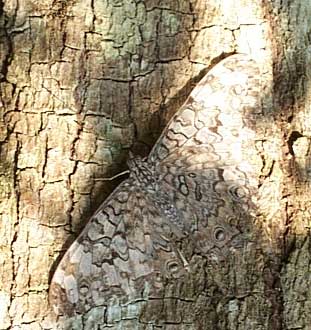Excerpts from Jim Conrad's
Naturalist Newsletter
from the December 15, 2005 Newsletter written at Hacienda San Juan Lizarraga one kilometer east of Telchac Pueblo, Yucatán, MÉXICO
and issued from Hotel Reef Yucatan 13 kms to the north
GRAY CRACKERS

The most conspicuous butterfly at the hacienda is not the Monarch I told you about some time back but rather a fairly large one with black-and-white, calico-like patterning. It's known around here as "Tronadora," meaning "Thunderer," and in English it's called the Gray Cracker. It's HAMADRYAS FEBRUA, a member of the family Nymphalidae, shown nicely camouflaged at the right.
Several well disguised Gray Crackers usually can be found perching flat-winged on the gray trunks of the tall Royal Palms along the road leading into the Big House. By "flat-winged" I mean that they perch with their wings flat against the smooth trunk, like a moth, not held above their backs like normal butterflies. This fact alone makes the species unusual.
The names suggest something else unusual about it ("cracker" as in "cracking sound"). Another Gray Cracker will fly by, or maybe nothing will fly by at all, and the butterfly launches into the air in a very conspicuous and aggressive manner. As he darts about almost too fast for the eyes to follow sometimes you hear surprisingly loud snapping sounds like those made by some grasshoppers when they fly up from the grass in late summer. Most flights seem to be made to check out other Gray Crackers, maybe to see if they are the opposite sex, but possibly they may be males defending territories against other males.
On cool mornings when dew still lies heavily on things, it's easy to approach to within inches of a Gray Cracker on a palm trunk for a good look. However, once they bask awhile in the sun they get nervous and are very quick to take flight at the slightest provocation.